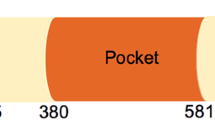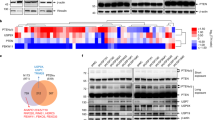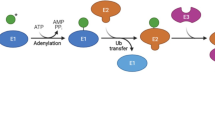Abstract
PTEN (phosphatase and tensin homolog deleted on chromosome 10) tumor suppressor regulates a variety of cellular processes including cell proliferation, growth, migration and death. This master regulator itself is also under deliberative regulation. Although the evidence for PTEN regulation and its significance in normal biology and disease is overwhelming, the mechanisms and exact functional consequences of PTEN regulation are far from clear. In this review, we discuss recent advances concerning post-translational regulation of PTEN in general, and in more detail about its regulation by ubiquitination. We also discuss some unsolved questions in the field and how they might be addressed in the future. We propose that the complex regulatory mechanisms of PTEN dictate how this tumor suppressor executes its distinct biological functions.
This is a preview of subscription content, access via your institution
Access options
Subscribe to this journal
Receive 50 print issues and online access
$259.00 per year
only $5.18 per issue
Buy this article
- Purchase on Springer Link
- Instant access to full article PDF
Prices may be subject to local taxes which are calculated during checkout



Similar content being viewed by others
References
Ali IU, Schriml LM, Dean M . (1999). Mutational spectra of PTEN/MMAC1 gene: a tumor suppressor with lipid phosphatase activity. J Natl Cancer Inst 91: 1922–1932.
Anan T, Nagata Y, Koga H, Honda Y, Yabuki N, Miyamoto C et al. (1998). Human ubiquitin-protein ligase Nedd4: expression, subcellular localization and selective interaction with ubiquitin-conjugating enzymes. Genes Cells 3: 751–763.
Backman SA, Stambolic V, Suzuki A, Haight J, Elia A, Pretorius J et al. (2001). Deletion of Pten in mouse brain causes seizures, ataxia and defects in soma size resembling Lhermitte–Duclos disease. Nat Genet 29: 396–403.
Brognard J, Sierecki E, Gao T, Newton AC . (2007). PHLPP and a second isoform, PHLPP2, differentially attenuate the amplitude of Akt signaling by regulating distinct Akt isoforms. Mol Cell 25: 917–931.
Brooks CL, Gu W . (2006). p53 ubiquitination: Mdm2 and beyond. Mol Cell 21: 307–315.
Cai Z, Semenza GL . (2005). PTEN activity is modulated during ischemia and reperfusion: involvement in the induction and decay of preconditioning. Circ Res 97: 1351–1359.
Chung JH, Ginn-Pease ME, Eng C . (2005). Phosphatase and tensin homologue deleted on chromosome 10 (PTEN) has nuclear localization signal-like sequences for nuclear import mediated by major vault protein. Cancer Res 65: 4108–4116.
Crackower MA, Oudit GY, Kozieradzki I, Sarao R, Sun H, Sasaki T et al. (2002). Regulation of myocardial contractility and cell size by distinct PI3K–PTEN signaling pathways. Cell 110: 737–749.
Di Cristofano A, Pesce B, Cordon-Cardo C, Pandolfi PP . (1998). Pten is essential for embryonic development and tumour suppression. Nat Genet 19: 348–355.
Dummler B, Hemmings BA . (2007). Physiological roles of PKB/Akt isoforms in development and disease. Biochem Soc Trans 35: 231–235.
Engelman JA, Luo J, Cantley LC . (2006). The evolution of phosphatidylinositol 3-kinases as regulators of growth and metabolism. Nat Rev Genet 7: 606–619.
Georgescu MM, Kirsch KH, Akagi T, Shishido T, Hanafusa H . (1999). The tumor-suppressor activity of PTEN is regulated by its carboxyl-terminal region. Proc Natl Acad Sci USA 96: 10182–10187.
Georgescu MM, Kirsch KH, Kaloudis P, Yang H, Pavletich NP, Hanafusa H . (2000). Stabilization and productive positioning roles of the C2 domain of PTEN tumor suppressor. Cancer Res 60: 7033–7038.
Gimm O, Perren A, Weng LP, Marsh DJ, Yeh JJ, Ziebold U et al. (2000). Differential nuclear and cytoplasmic expression of PTEN in normal thyroid tissue, and benign and malignant epithelial thyroid tumors. Am J Pathol 156: 1693–1700.
Groszer M, Erickson R, Scripture-Adams DD, Lesche R, Trumpp A, Zack JA et al. (2001). Negative regulation of neural stem/progenitor cell proliferation by the Pten tumor suppressor gene in vivo. Science 294: 2186–2189.
Hershko A, Ciechanover A . (1998). The ubiquitin system. Annu Rev Biochem 67: 425–479.
Hlobilkova A, Guldberg P, Thullberg M, Zeuthen J, Lukas J, Bartek J . (2000). Cell cycle arrest by the PTEN tumor suppressor is target cell specific and may require protein phosphatase activity. Exp Cell Res 256: 571–577.
Iijima M, Huang YE, Luo HR, Vazquez F, Devreotes PN . (2004). Novel mechanism of PTEN regulation by its phosphatidylinositol 4,5-bisphosphate binding motif is critical for chemotaxis. J Biol Chem 279: 16606–16613.
Kurlawalla-Martinez C, Stiles B, Wang Y, Devaskar SU, Kahn BB, Wu H . (2005). Insulin hypersensitivity and resistance to streptozotocin-induced diabetes in mice lacking PTEN in adipose tissue. Mol Cell Biol 25: 2498–2510.
Kwon CH, Luikart BW, Powell CM, Zhou J, Matheny SA, Zhang W et al. (2006). Pten regulates neuronal arborization and social interaction in mice. Neuron 50: 377–388.
Kwon CH, Zhu X, Zhang J, Knoop LL, Tharp R, Smeyne RJ et al. (2001). Pten regulates neuronal soma size: a mouse model of Lhermitte–Duclos disease. Nat Genet 29: 404–411.
Kwon J, Lee SR, Yang KS, Ahn Y, Kim YJ, Stadtman ER et al. (2004). Reversible oxidation and inactivation of the tumor suppressor PTEN in cells stimulated with peptide growth factors. Proc Natl Acad Sci USA 101: 16419–16424.
Lachyankar MB, Sultana N, Schonhoff CM, Mitra P, Poluha W, Lambert S et al. (2000). A role for nuclear PTEN in neuronal differentiation. J Neurosci 20: 1404–1413.
Lee JO, Yang H, Georgescu MM, Di Cristofano A, Maehama T, Shi Y et al. (1999). Crystal structure of the PTEN tumor suppressor: implications for its phosphoinositide phosphatase activity and membrane association. Cell 99: 323–334.
Li J, Yen C, Liaw D, Podsypanina K, Bose S, Wang SI et al. (1997). PTEN, a putative protein tyrosine phosphatase gene mutated in human brain, breast, and prostate cancer. Science 275: 1943–1947.
Lindsay Y, McCoull D, Davidson L, Leslie NR, Fairservice A, Gray A et al. (2006). Localization of agonist-sensitive PtdIns(3,4,5)P3 reveals a nuclear pool that is insensitive to PTEN expression. J Cell Sci 119: 5160–5168.
Liu X, Bruxvoort KJ, Zylstra CR, Liu J, Cichowski R, Faugere MC et al. (2007). Lifelong accumulation of bone in mice lacking Pten in osteoblasts. Proc Natl Acad Sci USA 104: 2259–2264.
Maccario H, Perera NM, Davidson L, Downes CP, Leslie NR . (2007). PTEN is destabilised by phosphorylation on threonine 366. Biochem J 405: 439–444.
Maehama T, Dixon JE . (1998). The tumor suppressor, PTEN/MMAC1, dephosphorylates the lipid second messenger, phosphatidylinositol 3,4,5-trisphosphate. J Biol Chem 273: 13375–13378.
Minaguchi T, Waite KA, Eng C . (2006). Nuclear localization of PTEN is regulated by Ca(2+) through a tyrosil phosphorylation-independent conformational modification in major vault protein. Cancer Res 66: 11677–11682.
Mirmohammadsadegh A, Marini A, Nambiar S, Hassan M, Tannapfel A, Ruzicka T et al. (2006). Epigenetic silencing of the PTEN gene in melanoma. Cancer Res 66: 6546–6552.
Mocanu MM, Yellon DM . (2007). PTEN, the Achilles' heel of myocardial ischaemia/reperfusion injury? Br J Pharmacol 150: 833–838.
Odriozola L, Singh G, Hoang T, Chan AM . (2007). Regulation of PTEN activity by its carboxyl-terminal autoinhibitory domain. J Biol Chem 282: 23306–23315.
Okahara F, Ikawa H, Kanaho Y, Maehama T . (2004). Regulation of PTEN phosphorylation and stability by a tumor suppressor candidate protein. J Biol Chem 279: 45300–45303.
Okumura K, Mendoza M, Bachoo RM, DePinho RA, Cavenee WK, Furnari FB . (2006). PCAF modulates PTEN activity. J Biol Chem 281: 26562–26568.
Okumura K, Zhao M, Depinho RA, Furnari FB, Cavenee WK . (2005). Cellular transformation by the MSP58 oncogene is inhibited by its physical interaction with the PTEN tumor suppressor. Proc Natl Acad Sci USA 102: 2703–2706.
Oren M . (2003). Decision making by p53: life, death and cancer. Cell Death Differ 10: 431–442.
Oudit GY, Kassiri Z, Zhou J, Liu QC, Liu PP, Backx PH et al (2008). Loss of PTEN attenuates the development of pathological hypertrophy and heart failure in response to biomechanical stress. Cardiovasc Res 78: 505–514.
Perren A, Weng LP, Boag AH, Ziebold U, Thakore K, Dahia PL et al. (1999). Immunohistochemical evidence of loss of PTEN expression in primary ductal adenocarcinomas of the breast. Am J Pathol 155: 1253–1260.
Planchon SM, Waite KA, Eng C . (2008). The nuclear affairs of PTEN. J Cell Sci 121: 249–253.
Podsypanina K, Ellenson LH, Nemes A, Gu J, Tamura M, Yamada KM et al. (1999). Mutation of Pten/Mmac1 in mice causes neoplasia in multiple organ systems. Proc Natl Acad Sci USA 96: 1563–1568.
Raftopoulou M, Etienne-Manneville S, Self A, Nicholls S, Hall A . (2004). Regulation of cell migration by the C2 domain of the tumor suppressor PTEN. Science 303: 1179–1181.
Reddy P, Liu L, Adhikari D, Jagarlamudi K, Rajareddy S, Shen Y et al. (2008). Oocyte-specific deletion of Pten causes premature activation of the primordial follicle pool. Science 319: 611–613.
Rosivatz E, Matthews JG, McDonald NQ, Mulet X, Ho KK, Lossi N et al. (2006). A small molecule inhibitor for phosphatase and tensin homologue deleted on chromosome 10 (PTEN). ACS Chem Biol 1: 780–790.
Ross SH, Lindsay Y, Safrany ST, Lorenzo O, Villa F, Toth R et al. (2007). Differential redox regulation within the PTP superfamily. Cell Signal 19: 1521–1530.
Sasaoka T, Wada T, Tsuneki H . (2006). Lipid phosphatases as a possible therapeutic target in cases of type 2 diabetes and obesity. Pharmacol Ther 112: 799–809.
Shen WH, Balajee AS, Wang J, Wu H, Eng C, Pandolfi PP et al. (2007). Essential role for nuclear PTEN in maintaining chromosomal integrity. Cell 128: 157–170.
Stambolic V, Suzuki A, de la Pompa JL, Brothers GM, Mirtsos C, Sasaki T et al. (1998). Negative regulation of PKB/Akt-dependent cell survival by the tumor suppressor PTEN. Cell 95: 29–39.
Steck PA, Pershouse MA, Jasser SA, Yung WK, Lin H, Ligon AH et al. (1997). Identification of a candidate tumour suppressor gene, MMAC1, at chromosome 10q23.3 that is mutated in multiple advanced cancers. Nat Genet 15: 356–362.
Stiles BL, Kuralwalla-Martinez C, Guo W, Gregorian C, Wang Y, Tian J et al. (2006). Selective deletion of Pten in pancreatic beta cells leads to increased islet mass and resistance to STZ-induced diabetes. Mol Cell Biol 26: 2772–2781.
Subauste MC, Nalbant P, Adamson ED, Hahn KM . (2005). Vinculin controls PTEN protein level by maintaining the interaction of the adherens junction protein beta-catenin with the scaffolding protein MAGI-2. J Biol Chem 280: 5676–5681.
Sun L, Hui AM, Su Q, Vortmeyer A, Kotliarov Y, Pastorino S et al. (2006). Neuronal and glioma-derived stem cell factor induces angiogenesis within the brain. Cancer Cell 9: 287–300.
Takahashi Y, Morales FC, Kreimann EL, Georgescu MM . (2006). PTEN tumor suppressor associates with NHERF proteins to attenuate PDGF receptor signaling. EMBO J 25: 910–920.
Tamura M, Gu J, Matsumoto K, Aota S, Parsons R, Yamada KM . (1998). Inhibition of cell migration, spreading, and focal adhesions by tumor suppressor PTEN. Science 280: 1614–1617.
Tolkacheva T, Boddapati M, Sanfiz A, Tsuchida K, Kimmelman AC, Chan AM . (2001). Regulation of PTEN binding to MAGI-2 by two putative phosphorylation sites at threonine 382 and 383. Cancer Res 61: 4985–4989.
Torres J, Pulido R . (2001). The tumor suppressor PTEN is phosphorylated by the protein kinase CK2 at its C terminus. Implications for PTEN stability to proteasome-mediated degradation. J Biol Chem 276: 993–998.
Trotman LC, Alimonti A, Scaglioni PP, Koutcher JA, Cordon-Cardo C, Pandolfi PP . (2006). Identification of a tumour suppressor network opposing nuclear Akt function. Nature 441: 523–527.
Trotman LC, Niki M, Dotan ZA, Koutcher JA, Di Cristofano A, Xiao A et al. (2003). Pten dose dictates cancer progression in the prostate. PLoS Biol 1: E59.
Trotman LC, Wang X, Alimonti A, Chen Z, Teruya-Feldstein J, Yang H et al. (2007). Ubiquitination regulates PTEN nuclear import and tumor suppression. Cell 128: 141–156.
Valiente M, Andres-Pons A, Gomar B, Torres J, Gil A, Tapparel C et al. (2005). Binding of PTEN to specific PDZ domains contributes to PTEN protein stability and phosphorylation by microtubule-associated serine/threonine kinases. J Biol Chem 280: 28936–28943.
Vazquez F, Matsuoka S, Sellers WR, Yanagida T, Ueda M, Devreotes PN . (2006). Tumor suppressor PTEN acts through dynamic interaction with the plasma membrane. Proc Natl Acad Sci USA 103: 3633–3638.
Vazquez F, Ramaswamy S, Nakamura N, Sellers WR . (2000). Phosphorylation of the PTEN tail regulates protein stability and function. Mol Cell Biol 20: 5010–5018.
Walker SM, Leslie NR, Perera NM, Batty IH, Downes CP . (2004). The tumour-suppressor function of PTEN requires an N-terminal lipid-binding motif. Biochem J 379: 301–307.
Wang X, Trotman LC, Koppie T, Alimonti A, Chen Z, Gao Z et al. (2007). NEDD4-1 is a proto-oncogenic ubiquitin ligase for PTEN. Cell 128: 129–139.
Wang X, Shi Y, Wang J, Huang G, Jiang X . (2008). The crucial role of the carboxyl terminus of PTEN in antagonizing NEDD4-1-mediated PTEN ubiquitination and degradation. Biohem J (E-pub ahead of print).
Weng L, Brown J, Eng C . (2001). PTEN induces apoptosis and cell cycle arrest through phosphoinositol-3-kinase/Akt-dependent and -independent pathways. Hum Mol Genet 10: 237–242.
Whang YE, Wu X, Suzuki H, Reiter RE, Tran C, Vessella RL et al. (1998). Inactivation of the tumor suppressor PTEN/MMAC1 in advanced human prostate cancer through loss of expression. Proc Natl Acad Sci USA 95: 5246–5250.
Whiteman DC, Zhou XP, Cummings MC, Pavey S, Hayward NK, Eng C . (2002). Nuclear PTEN expression and clinicopathologic features in a population-based series of primary cutaneous melanoma. Int J Cancer 99: 63–67.
Wiencke JK, Zheng S, Jelluma N, Tihan T, Vandenberg S, Tamguney T et al. (2007). Methylation of the PTEN promoter defines low-grade gliomas and secondary glioblastoma. Neuro Oncol 9: 271–299.
Wijesekara N, Konrad D, Eweida M, Jefferies C, Liadis N, Giacca A et al. (2005). Muscle-specific Pten deletion protects against insulin resistance and diabetes. Mol Cell Biol 25: 1135–1145.
Wu W, Wang X, Zhang W, Reed W, Samet JM, Whang YE et al. (2003). Zinc-induced PTEN protein degradation through the proteasome pathway in human airway epithelial cells. J Biol Chem 278: 28258–28263.
Yilmaz OH, Valdez R, Theisen BK, Guo W, Ferguson DO, Wu H et al. (2006). Pten dependence distinguishes haematopoietic stem cells from leukaemia-initiating cells. Nature 441: 475–482.
Zhang J, Grindley JC, Yin T, Jayasinghe S, He XC, Ross JT et al. (2006). PTEN maintains haematopoietic stem cells and acts in lineage choice and leukaemia prevention. Nature 441: 518–522.
Acknowledgements
We thank Dr Ian Ganley for critical reading and suggestions. This work was supported by an American Cancer Society Scholar fund (to XJ) and a Geoffrey Beene Cancer Research fund (to XJ).
Author information
Authors and Affiliations
Corresponding author
Rights and permissions
About this article
Cite this article
Wang, X., Jiang, X. Post-translational regulation of PTEN. Oncogene 27, 5454–5463 (2008). https://doi.org/10.1038/onc.2008.242
Published:
Issue Date:
DOI: https://doi.org/10.1038/onc.2008.242
Keywords
This article is cited by
-
Functional roles of E3 ubiquitin ligases in prostate cancer
Journal of Molecular Medicine (2022)
-
USP13 functions as a tumor suppressor by blocking the NF-kB-mediated PTEN downregulation in human bladder cancer
Journal of Experimental & Clinical Cancer Research (2019)
-
Impact of Topoisomerase IIα, PTEN, ABCC1/MRP1, and KI67 on triple-negative breast cancer patients treated with neoadjuvant chemotherapy
Breast Cancer Research and Treatment (2019)
-
PTEN/PTENP1: ‘Regulating the regulator of RTK-dependent PI3K/Akt signalling’, new targets for cancer therapy
Molecular Cancer (2018)
-
Activation of nuclear PTEN by inhibition of Notch signaling induces G2/M cell cycle arrest in gastric cancer
Oncogene (2016)



